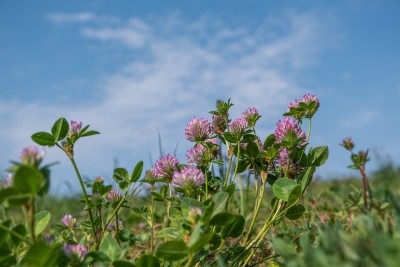Tips for Successful Frost Seeding
Amy Barkley, Team Leader & Livestock Specialist
Southwest New York Dairy, Livestock and Field Crops Program

Frost seeding is a low input and low disturbance method of improving pastures and hayfields. If potential pitfalls are addressed prior to seed getting on the ground, it can result in a more productive stand. Below are some tips to help you have the best success with frost seeding.
Which pastures and hayfields are the best candidates for frost seeding?
The best pastures and hayfields are those which have an appropriate pH for the seed you're planting in addition to reduced vegetative matter cover. The year prior to frost seeding, the resident forage should have been grazed or mowed lower to allow for reduced resident forage vigor in the spring, thereby reducing competition with the new seedlings once they germinate.
Pastures or hayfields with bare spots are also great candidates. Bare areas have limited innate competition, and seeding them will increase that field's overall yield.
What kind of seed should I use?
Legumes (clovers, birdsfoot trefoil) are the best for frost seeding because they can survive low temperatures and naturally work their way through cracks in the snow, ice, and soil profile because of their round shape and relatively higher density. The larger, flatter, lighter seed of grasses doesn't work as well because it will be more prone to stay on the soil surface… that is, if it doesn't blow away! That said, some producers find that they can successfully frost seed timothy, orchard grass, and tall fescue.
Seeding rates are different when frost seeding
You'll want to aim for a higher rate than what's listed on the seed bag because not all of the seed is being applied directly to the soil and incorporated. There is loss associated with this type of seeding. According to numbers published by Penn State University, Pasture renovation frost seeding rates for red clover are 4-8 pounds/acre, yellow clover is 5-10 pounds/acre, white and ladino clover is 2-3 pounds/acre, and trefoil is applied at a rate of 4-6 pounds per acre.
Timing
As the name suggests, frost seeding is best done in late winter or early spring when the frost is leaving the soil. While frost seeding with snow on the ground is attractive because you can see where you've gone over the field, keep in mind that we're trying to plant a very small seed that has to make it all the way down to the soil without cold damage, being consumed by wildlife, or being blown away by wind. If you do choose to frost seed when there is snow on the ground, make sure that you can see the ground poking through the bed of snow to give the seed it's best chance.
How does soil type impact frost seeding success?
The good news for farmers in most of WNY is that our soils are prime for frost seeding. Heavier clay and silt-loam soils hold more water by nature, and therefore have a much more dramatic freeze-thaw cycle. This opens cracks in the soil to get the seed in good contact with soil. These soils are more successfully frost seeded when compared to soils that are sandier in texture.
Does soil fertility matter when frost seeding?
Fertility for legumes that are frost seeded follow the same rules of legumes that are planted any other time of the year. Clovers do best in a pH of 6 - 7, while trefoil does well in soils down to a pH of 5.5. Soils that has a pH outside of these ranges are going to result in reduced seedling vigor and quicker stand depletion.
By following these tips, whether you're a first time or seasoned frost seeder, you can experience the benefits of frost seeding. Questions on frost seeding? Contact Amy Barkley at (716) 640-0844 or amb544@cornell.edu
Upcoming Events
Memoir Reading: Barn Gothic
December 4, 2025
Bath, NY
Barn Gothic is an elegy for family farmers and an intimate portrait of three generations laboring to be fathers and sons while their livelihood falls apart. Beautifully told with a farmer's restraint and a poet's grace, it is a story of personal loss amid corporate corruption and of finding a way forward when everything you know disappears.
NY Small Farms Summit 2025: Stronger Together
December 5, 2025
Alfred, NY
We hope you will join us on December 5th for the 2025 New York Small Farms Summit! This is an opportunity to meet other farmers and ag supporters, learn about research and education projects, and set priorities for future efforts to grow small farm success.
At the Allegany County site, we will focus on giving trees a chance and how trees build resiliency on small farms. Whether attracted to fruit, nuts, vegetables, fodder or shade, trees can be an integral part of a successful farming system. Join us as we explore the opportunities for resiliency that come from adding tree crops or managing wooded areas of your farm for agroforestry or silvopasture systems.
Crops, Cows & Critters - Southwest New York Dairy, Livestock & Field Crops Newsletter Sponsorship
December 19, 2025
Our two forms of publications feature research-based and timely information from our four specialists, listed to the right, along with local event notifications and Cornell University outreach. This information is provided to participants who range from dairy, livestock, and field crops producers to agricultural suppliers and consultants.
Weekly Email Update: Shared with 625+ households who have signed up with our program.
Monthly Paper Mailer: To reach our stakeholders and farmers who lack internet access, we send out a monthly mailer where your company's logo and contact information would be featured with a mailing list of 330+ households.
If you sponsor our weekly and monthly publications you reach approximately 955 households.
Visit our website to view our newsletters!
Announcements
No announcements at this time.





